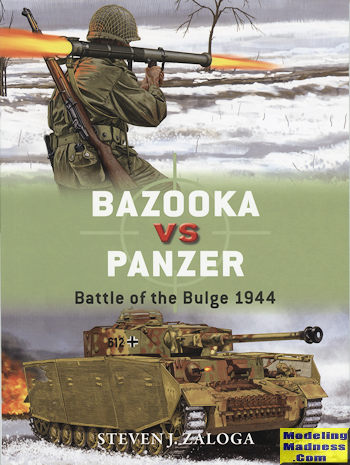
|
Author: |
Steven J. Zaloga |
|
Publisher/Distributor |
Osprey Publishing |
|
Price |
$20.00 MSRP |
|
Reviewer: |
|
| Notes: |
80 pages, 7¼ x 9¼ inches, softcover ISBN: 978-1-4728-1249-0 |

Osprey's Duel series has taken on a rather interesting match-up this time. It is the bazooka and its effects on German tanks. Most of you are aware that the bazooka is one of the earliest RPGs and a similar weapon to the British PIAT. While many consider it superior to the PIAT, the British, in their stubborn way, decided it was unfit for British Army use and so those sent to them spent most of their war in warehouses.
However, once trained to use them, the American Army liked them. They had as much hitting power as the British-based 57mm anti-tank gun and were a lot easier to operate. Not only that, but they did not have to be towed or manhandled into firing position. The German Panzerfaust and similar weapons were based on the American bazookas captured during the North African campaign. German weapons were larger, had more punch and were both heavier and longer. Unlike the bazooka, the German weapons had a face shield to keep the operator from suffering from the effects of the rocket blast as it exited the tube.
This book covers the interesting development of the bazooka in its two basic forms as well as the development of the rockets that it used. Interestingly, since the bazooka warhead was a shaped charge, it was found that a rounded head to the rocket was more effective than the pointed version. The book also goes into considerable detail on the German use of various methods of defending their tanks against it. Many think that the use of shurzen, or screens on the side of tanks was due to RPGs. In fact, it was not, and was developed to provide protection from Russian anti-tank rifles. An interesting fact discovered during post war testing was that these side screen, whether sheet metal or mesh, actually improved the effectiveness of RPG hits by delaying the explosion of the shaped charge and causing deeper penetration.
US infantry in western Europe only came up against concentrated German armor one time during the war. That was during the Battle of the Bulge. The author expends considerable print in describing one small aspect of that campaign in which the bazooka played a major role. Such was the development of AFV armor, that by the time of the Korean War, a larger version of the bazooka had to be developed to handle the armor of North Korean T-34/85s. It was also interesting to read that the vast majority of bazooka rounds were expended not against enemy tanks, but other hardpoints such as bunkers and reinforced buildings. Thanks to the great choice of period photos and some excellent art work, we get the full story of this interesting weapon and its use during WWII. Highly recommended reading for all with an interest.
November 2016
Copyright ModelingMadness.com. All rights reserved.
For more on the complete line of Osprey books, visit http://ospreypublishing.com.
If you would like your product reviewed fairly and quickly, please contact me or see other details in the Note to Contributors.